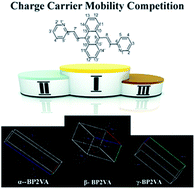Polymorphism dependent charge transport property of 9,10-bis((E)-2-(pyrid-2-yl)vinyl)anthracene: a theoretical study†
Abstract
The charge transport properties of three crystalline polymorphs (α, β and γ) of 9,10-bis((E)-2-(pyrid-2-yl)vinyl)anthracene (BP2VA) were investigated at the first-principle level using Density Functional Theory (DFT) method based on Marcus theory, as well as the hybrid quantum mechanical and molecular mechanical (QM/MM) method. The polymorphism dependent charge transport property was explored by the calculation and analysis of the reorganization energy, the transfer integral, as well as the charge carrier mobilities of three different crystalline polymorphs. The results show that (1) β-BP2VA has the highest charge carrier mobility (for hole is 0.988 cm2 V−1 s−1 and for electron is 0.053 cm2 V−1 s−1) among the three crystalline polymorphs. (2) Comparison of the reorganization energy between individual molecule in gas-phase and embedded molecule when considering the steric effect of surrounding molecules suggests that the reorganization energy is dependent on intermolecular interaction for BP2VA. The calculated charge carrier mobilities are strongly dependent on the crystalline polymorphs. The enlightenment to us is that during the designing of optoelectronic materials with high charge mobility, we should pay attention to the molecular packing mode in the bulk material besides the molecular structure itself.


 Please wait while we load your content...
Please wait while we load your content...